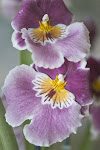There must be more weird-shaped islands and caves here than anywhere else in the world. (Great for hiding pirate ships and all their booty.)




There were only 12 of us spending this day together--a couple from England and several from Australia. Have met so many interesting folks on my tours. Traveling alone is not as "lonely" as it might seem. I usually end up getting to know many new people from all over the world.
 Stalactites hang down from the outer edges of the fantastically shaped islands.
Stalactites hang down from the outer edges of the fantastically shaped islands. This rope marks an inner cave where birds' nests can be gathered at a certain time of the year when the swallows nest in them. The nests sell for an astronomical price--100,000 baht per nest.
This rope marks an inner cave where birds' nests can be gathered at a certain time of the year when the swallows nest in them. The nests sell for an astronomical price--100,000 baht per nest. A multitude of sea caves provided secret hiding places for pirates.
A multitude of sea caves provided secret hiding places for pirates.
A kayaker's playground.


 Approaching James Bond island.
Approaching James Bond island. Muslim vendors lined the beach awaiting the arrival of tourists.
Muslim vendors lined the beach awaiting the arrival of tourists. Spectacular rock formations provided lots of photo ops for young couples.
Spectacular rock formations provided lots of photo ops for young couples. Beautiful beach at James Bond Island (probably has another, local name but that's what everyone calls it now.)
Beautiful beach at James Bond Island (probably has another, local name but that's what everyone calls it now.) This is the famous landmark rock from the movie.
This is the famous landmark rock from the movie. Caves and sea arches surround the island and you can take a boat right through this one.
Caves and sea arches surround the island and you can take a boat right through this one.Our next stop was at a floating village at one of the islands. Originally a Muslim fishing village--and still an active, working one, the women have taken to selling gift items to tourists, as well. The place is quite amazing--all on stilts in the middle of the ocean. Generators supply the only power--and then only for several hours each day because of the expense. Fresh water and kerosene sell for premium prices as these supplies must all be shipped into the village on long tail boats.
We stopped by the school that serves the village, were able to peer into people's open-air homes (little more than shacks), and had lunch at a restaurant on stilts. The guide asked us NOT to take photos of the animals that were offered for that purpose, e.g. endangered gibbons and hawks, because it only encourages the people to go out and catch more of them. (They charge for a photo.)
 Approaching the village.
Approaching the village.
 This is a fish trap.
This is a fish trap. This school on stilts where you can hear the water washing up below was just like any other school in Thailand.
This school on stilts where you can hear the water washing up below was just like any other school in Thailand.
 Restaurant where we had lunch
Restaurant where we had lunch




After we left the floating village, we headed for another island with a long sand beach for swimming. En route, we ran into a heavy rain storm. The placid sea kicked up a bit and we had to shelter below deck. It was the first time I've heard thunder here in Thailand.

Peering out at the rain through a window on the lower deck.

After the rain quit, we reached our beach destination.
 If you want to sit in one of these beach chairs on this otherwise deserted island, it will cost you 100 baht ($3.00).
If you want to sit in one of these beach chairs on this otherwise deserted island, it will cost you 100 baht ($3.00).
Quintessential "beach bar."

When I finally arrived back at the hotel, it was to a spectacular sunset.

The next two days before I return to Bangkok--and then fly out for home, I intend to "take it easy" and enjoy where I am staying. They have two swimming pools--and a beautiful sister resort (far more expensive) up on the hill from here, where we have full privileges.
Think I need to check out the amenities--maybe the spa?
Arrive home in Maui March 1st.





























